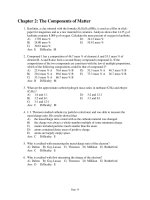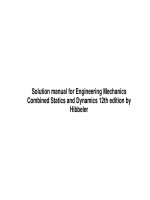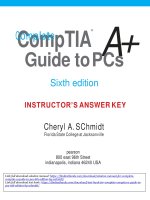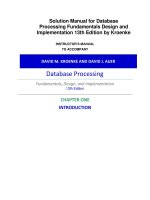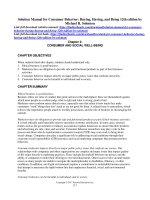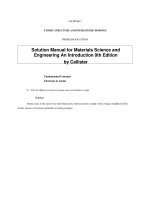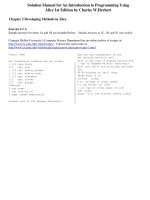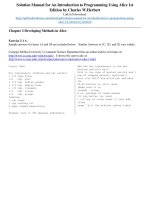Solution manual for chemistry the molecular nature of matter 7th edition by jespersen hyslop
Bạn đang xem bản rút gọn của tài liệu. Xem và tải ngay bản đầy đủ của tài liệu tại đây (278.75 KB, 15 trang )
Solution Manual for Chemistry The Molecular Nature of Matter 7th edition by Neil
D. Jespersen, Alison Hyslop
Link full download test bank: />Link full download solution manual: />
Chapter One: Scientific Measurements
Practice Exercises
1.1
The scientific method is an iterative process of gathering information through making observations and
collecting data and then formulating explanations that lead to a conclusion.
1.2
(a) element
(d) mixture, heterogeneous
(b) mixture, homogeneous
(e) element
1.3
(a) chemical change
(c) physical change
(b) physical change
(d) physical change
1.4
(a) intensive
(c) intensive
(b) extensive
(d) extensive
1.5
V = r3, the SI unit for radius, r, is meters, the numbers
4
(c) compound
4
3
and do not have units. Therefore,
3
the SI unit for volume is meter3 or m3.
1.6
Force equals mass × acceleration (F = ma), and acceleration equals change in velocity divided by change in
change in v
d
time (a =
), and velocity equals distance divided by time (v = ). Put the
t
change in t
equations together:
change in v
F=m
change
in
t
d
change in
change
in
d
t
F= m change in t = m
2
change in t
The unit for mass is kilogram (kg); the unit for distance is meter (m) and the unit for time is second (s).
Substitute the units into the equation mabove:
Unit for force in SI base units = kg
or kg m s–2
s2
1.7
1.8
9 F
9 F
+ 32 F =
355 C + 32 °F =671 F
tF
Ct
5 C
5 C
t t 32 F
C
5 C 55
o
9 F
F
F 32 F
5 C 13 C
9 F
To convert from °F to K we first convert to °C.
t t 32 F
C
5 C 68 °F 32 F 5 C 20 C
F
T = (273 °C + t )
K
1.9
(a)
(b)
9 F
1K
C
9 F
1K
= (273 °C + 20 °C)
1 C
= 293 K
1 C
21.0233 g + 21.0 g = 42.0233 g: rounded correctly to 42.0 g
10.0324 g / 11.7 mL = 0.8574 g / mL: rounded correctly to 0.857 g/mL
1-1
14.25 cm 12.334 cm
(c)
1.10
2.223 cm 1.04 cm
54.183 g – 0.0278 g = 54.155 g
10.0 g + 1.03 g + 0.243 g = 11.3 g (rounded after adding)
(a)
(b)
1 ft
= 3.62 ft (1 and 12 are exact numbers)
12 in.
43.4 in ×
(c)
1.03 m 2.074 m 2.9 m
(d)
1.11
1.12
m 2 = 124 ft
2
30.48 cm 2 1 m 2
3
= 11.5 m 2
3 ft 3 12 in. 3
3
= 140,000 in. = 1.40 10
in.3 = 3.00 yd
(b)
cm = 1.25 km
(c)
28.35
g1km 1 m
g = 3.27 oz
= 92.7 g
1000
ft
1myd100
1 cm
km
Density =
=
Density =
in
3
5
= 1.25 10 cm
20.2 mile 1.609 km 1 gal
= 8.59 km
1 gal 1 mile 3.785 L
mass
mass
0.244 g
15.0 mL
volume
Density =
5
1 oz
volume
1.15
100 cm
1 ft
(a)
L
1.14
= 0.36 m2
12.46 m 4.778 m
(d)
1.13
= 148.57 cm: rounded correctly to 149 cm
L
= 0.0163 g/mL = 0.0163 g cm–3
0.547 g
mass
=
V f Vi
(5.95 mL – 5.70 mL)
=2.2 g mL–1 = 2.2 g cm–3
mass
volume
Density of the object =
365 g
= 16.5 g/cm3
3
22.12 cm
The object is not composed of pure gold since the density of gold is 19.3 g/cm3.
1.16
The density of the alloy is 12.6 g/cm3. To determine the mass of the 0.822 ft3 sample of the alloy, first
convert the density from g/cm3 to lb/ft3, then find the weight.
3
12.6 g 1 lb 30.48 cm
3
1 ft
cm 453.6 g
3
Density in lb/ft =
= 787 lb/ft
Mass of sample alloy = (0.822 ft3) (787 lb/ft3) = 647 lb
1.17
specific gravity =
density of substance
density of water
1.090 =
density of wine
62.4 lb ft
3
density of wine = 1.090 62.4 lb ft3 = 68.02 lb ft3
1-2
3
ft
mass of wine = 79 gallons density of wine
3
7.481 gallons
68.02 lb
= 79 gallons
1 ft
1.18
specific gravity =
density of water =
ft
3
3
= 720 lb
7.481 gallons
density of substance
density of water
1.00 g
1 oz
29.574 mL
= 1.043 oz/liquid oz
1 mL 28.3495 g 1 liquid oz
1.008 oz/liquid oz
specific gravity of urine =
= 0.966
1.043 oz/liquid oz
The specific gravity of urine is below the normal range.
Review Questions
1.1
This answer will be student dependent.
1.2
Observation, testing and explanation.
1.3
(a)
(b)
(c)
A law is a description of behavior based on the results of many experiments which are true while a
theory is a tested explanation of the results of many experiments.
An observation is a statement that accurately describes something we see, hear, taste, feel or smell
while a conclusion is a statement that is based on a series of observations.
Data are the observations made while performing experiments.
1.4
A theory is valid as long as there is no experimental evidence to disprove it. Any experimental evidence
that contradicts the theory, and therefore, disproves the theory.
1.5
Matter has mass and occupies space. All items, except (b) an idea, in the question are examples of matter.
1.6
(a)
(b)
(c)
(d)
(e)
(f)
(g)
An element is a pure substance that cannot be decomposed into something simpler.
A compound is a pure substance that is composed of two or more elements in some fixed or
characteristic proportion.
Mixtures result from combinations of pure substances in varying proportions.
A homogeneous mixture has one phase. It has the same properties throughout the sample.
A heterogeneous mixture has more than one phase. The different phases have different properties.
A phase is a region of a mixture that has properties that are different from other regions of the
mixture.
A solution is a homogeneous mixture.
1.7
Changing a compound into its element is a chemical change.
1.8
(a)
(e)
(i)
F
Li
Hg
(b)
(f)
(j)
Se
P
Mn
(c)
(g)
1-3
Ni
I
(d)
(h)
Ar
Ga
1.9
(a)
(d)
(g)
(j)
sodium
tin
cobalt
nitrogen
1.10
(a)
This is a heterogeneous mixture.
This is a pure substance and is an element, such as H2, O2, N2 or a halogen.
This is a homogeneous mixture.
This is a pure substance and is a molecule such as H2O.
(b)
(c)
(d)
1.11
(a)
(b)
(c)
(b)
(e)
(h)
zinc
magnesium
aluminum
(c)
(f)
(i)
silicon
tungsten
oxygen
Diagrams (a) and (d) contain pure elements
Diagram (c) contains a compound
Diagram (a) and (b) contain diatomic molecules
1.12
A physical change does not change the chemical composition of matter. Melting, boiling, change of shape,
or mass, and the formation of a mixture are examples of physical changes to matter.
A chemical change changes the chemical composition of matter. Formation of new compounds from the
reaction of other substances is an example.
A chemical changes involves the change in composition while a physical change does not change in the
composition of matter.
1.13
The reaction of calcium metal with water is a chemical change resulting in the formation of new
compounds, hydrogen gas and calcium hydroxide. It is not stated in the problem, but the water also
increases in temperature, which is a physical change.
1.14
These are all physical changes.
1.15
A chemical property describes a property that changes the chemical nature of a substance while physical
properties describe properties that do not change the chemical nature of a substance. For example, boiling
water does not change the chemical composition of water.
1.16
Extensive properties, such as volume, and size, are properties that depend on the amount of substance or
mass of substance while intensive properties, such as density, are not dependent on the amount of
substance. The density of a milliliter of water is the same as the density of a liter of water at the same
temperature.
1.17
(a)
(b)
Extensive
Intensive
(c)
(d)
Intensive
Extensive
(e)
Intensive
(f)
Intensive
(g)
Extensive
Mass is a mass dependent property.
The boiling point of a substance is the same for a mL as it is for a L of the compound
so it is mass independent.
The color of a substance does not change when you change the amount of substance.
Surface area depends on the amount of substance. It also depends on the nature of the
substance. A bar of metal has a smaller surface area than that of the same bar ground
into fine particles.
The physical state, gas, liquid, or solid, depends on temperature and pressure but not
on the mass of the substance.
The density of 1.0 g of water is the same as 100.0 g if both samples are at the same
temperature. Thus, density is not dependent on the mass of substance.
The volume occupied by a substance is dependent on the mass of substance.
1-4
1.18
(a)
(b)
(c)
Gas
Liquid
Solid
Temperature, density, volume, viscosity
Temperature, density, volume, viscosity
Temperature, density, volume
1.19
Measurements involve a comparison. The unit gives the number meaning.
1.20
Kilogram
1.21
Kilogram, meter, second, kelvin
1.22
Derived units are a result of multiplying or dividing a unit by 1, by a multiplier, or by another unit.
Examples include m2 for area, m/s for velocity, kg m/s2 for energy.
1.23
(a)
(b)
(c)
(d)
(e)
(f)
(g)
0.01
0.001
1000
0.000001
0.000000001
0.000000000001
1,000,000
10–2
10–3
103
10–6
10–9
10–12
106
c
m
k
(the Greek letter mu)
n
p
M
1.24
The melting points and boiling points of water at 1 atmosphere pressure. On the Celsius scale these points
correspond to 0 °C and 100 °C respectively.
1.25
(a) 1 Fahrenheit degree < 1 Celsius degree
(b) 1 Celsius degree = 1 Kelvin
(c) 1 Fahrenheit degree < 1 Kelvin
1.26
The digits that are significant figures in a quantity are those that are known (measured) with certainty plus
the last digit, which contains some uncertainty.
1.27
Rounding numbers: if the number after the significant figure is less than 5, keep the number. If the number
after the significant figure is 5 or more, and if it is 5 and the 5 is followed by nonzero digits, raise the
number by 1. If the number after the significant figure is 5, and followed by a zero, drop the 5 if the
preceding digit is even, add 1 if it is odd.
1.28
The accuracy of a measured value is the closeness of that value to the true value of the quantity. The
precision of a number of repeated measurements of the same quantity is the closeness of the measurements
to one another.
1.29
The minimum uncertainty that is implied in this measurement is ± 0.01 cm.
1.30
In addition, the significant figures are the least precise number. In multiplication, the number of significant
figures in the answer depends on smallest number of significant figures.
1.31
The unit that you start with is the denominator and the desired unit is the numerator.
1.32
The problem with using the fraction 3 yd/1 ft as a conversion factor is that there are 3 feet in one yard. The
conversion factor should be 1 yd/3 ft. For the second part of the question, it is not possible to construct a
valid conversion factor relating centimeters to meters from the equation 1 cm = 1000 m, since 100 cm = 1
m.
1-5
1.33
To convert 250 seconds to hours multiply 250 by:
1h
3600 s
To convert 3.84 hours to seconds multiply 3.84 hours by:
3600 s
1h
1.34
Four significant figures would be correct because the conversion factor contains exact values.
measured value determines the number of significant figures.
1.35
d=
m
The
: d = density; m = mass; V = volume
V
1.36
Density is the ratio of the mass of a substance divided by its volume and is an intensive property. Specific
gravity is the ratio of the density of a substance divided by the density of water using the same units.
Specific gravity does not have any units. Specific gravity is useful since it avoids units, and only the
density of water with the desired units needs to be tabulated.
1.37
The answer will be student dependent, but some answers might be g/mL, lb/ gallon, kg/L, ft3/lb. These
would have to be divided by the density of water with the same units: 1.00 g/mL, 8.34 lb/gallon, 1.00 kg/L,
62.4 lb/ft3 at 25 °C.
1.38
10.5 g silver = 1 cm3 silver
10.5 g Ag
1 cm3
3
and
1 cm
10.5 g Ag
Review Problems
1.39
(a)
(b)
(c)
(d)
(e)
1.40
(a)
(b)
(c)
(d)
(e)
1.41
(a)
(b)
(c)
Physical change. Copper does not change chemically when electricity flows through it: It remains
copper.
Physical change. Gallium is changes its state, not its chemical composition when it melts.
Chemical change. This is an example of the Maillard reaction describing the chemical reaction of
sugar molecules and amino acids.
Chemical change. Wine contains ethanol which can be converted to acetic acid.
Chemical change. Concrete is composed of many different substances that undergo a chemical
process called hydration when water is added to it.
Chemical change. Iron reacts with oxygen to form the rust.
Physical change. When corn is popped water is turned into steam by heating the corn. The
pressure of the steam caused the kernel to pop open resulting in popped corn.
Physical change. Generally alloys are mixtures of substances and no chemical change occurs. On
occasion, a chemical change can occur during the production of an alloy.
Physical change. During the production of butter fat molecules aggregate, due to the agitation of
whipping, and separate from the water.
Physical change. The water vapor becomes the liquid and does not change its chemical
composition.
Hydrogen is a gas at room temperature.
Aluminum is a solid at room temperature.
Nitrogen is a gas at room temperature.
1-6
1.42
1.43
(d)
Mercury is a liquid at room temperature.
(a)
(b)
(c)
(d)
Potassium chloride is a solid at room temperature.
Carbon dioxide is a gas at room temperature.
Methane is a gas at room temperature.
Sucrose is a solid at room temperature.
(a)
0.01
(b)
1000
(c)
1012
(d)
0.1
(e)
0.001
(f)
(b)
(e)
10–6
10–3
(c)
(f)
103
0.1
1.44
(a)
(d)
10–9
106
1.45
(a)
t =
F
(t ) + 32 F =
5 C
(57 °C) + 32 °F = 135 F when rounded to the proper
5 C
C
number of significant figures.
5 C
(–25.5 °F – 32 °F) = –31.9 C
t = 5 C (t – 32 F) =
(c)
1 C
1 C
C
= (378 K – 273 K) = 105
t = (T – 273 K)
C
9 F
9 F
F
1K
1K
T = (t + 273 °C)
= (–31 + 273)
(d)
K
K
1 C
5 C
C
t = 5 C (t
C
(a)
– 32 °F) =
F
F
99F
1 C
(98 °F – 32 °F) = 37 C
9 F9 F
(–55 °C) +32 °F = –67 F
t =
(c)
1 C
1 C
C
= (299 K – 273 K) = 26
t = (T – 273 K)
F
(t ) + 32 °F =
1 K
1 K = 242 K
(b)
5 C
C
5 C
1K
1 K
1K
1K
= 313 K
T = (t + 273 °C)
= (40 °C + 273 °C)
C
(d)
K
K
1 C
C
1.47
9 F
(b)
C
1.46
9 F
1 C
Temperature in °C:
1 C
1 C
× 106 C
t = (T – 273 K) = (15.7 × 106 K – 273 K) = 15.7
C
K
1 K
1 K
Temperature
9 F in °F:
9 F
t=
(C) + 32 °F =
(15.7 × 106 C) + 32 °F = 2.83 × 107 F
F
1.48
0.01
5 C
5 C
Temperature in °C:
1 C
K – 273 K) 1 C = –164
C
t = (T – 273 K)
= (109
C
K
1 K
1 K
Temperature
9 F in °F:
9 F
t=
(C) + 32 °F =
(–164 C) + 32 °F = –263.2 F
F
5 C
5 C
1-7
1.49
t 32 F
t
5 C
103.5 oF 32 F
5 C
9 F
39.7 C
1.50
9 F
This dog has afever;
above
out of normal canine range.
5isC
5 C the temperature
t 32 F
120.0 oF 32 F
48.89 C
t
C
F
9 F
9 F
The temperature in Death Valley, 56.7 °C, was warmer.
1.51
9.2 cm, 2 significant figures; 9.15 cm, 3 significant figures
1.52
24.25 °C, 4 significant figures; 18.9 °C, 3 significant figures
1.53
(a)
(c)
(e)
4 significant figures
4 significant figures
2 significant figures
(b)
(d)
5 significant figures
2 significant figures
1.54
(a)
(c)
(e)
3 significant figures
1 significant figures
1 significant figure
(b)
(d)
6 significant figures
5 significant figures
1.55
(a)
(c)
0.72 m2
(b)
84.24 kg
4.19 g/cm3 (dividing a number with 4 sig. figs by one with 3 sig. figs) (d)
19.42 g/mL
(e)
858.0 cm2
1.56
(a)
(c)
(e)
2.06 g/mL
12.4 g/mL
0.0006 m/s2
1.57
(a)
finite number of significant figures
exact number
finite number of significant figures
finite number of significant figures
C
(b)
(c)
(d)
1.58
(a)
(b)
(c)
(d)
1.59
F
(a)
(b)
(d)
finite number of significant figures
finite number of significant figures
finite number of significant figures
exact number
1m
km/hr = 32.0 dm/s
(b)
(d)
(e)
3600 s
1 km
= 11.5 km/h
m
1
h
10 dm 1000
6
1 10 g 1000 mL
1g
g/L = 8.2 mg/mL
(c)
4.02 mL
0.276 g/mL
1000mg
1g
1 kg
1g
= 7.53 10
1000
1 L mg 1000 g
L = 137.5 mL
= 0.1375 L
1000
1000
mLmL
mL = 0.025 L
= 25 mL
kg = 75.3 mg
1L
1-8
1 L
5
kg
6
= 8.2 10
g/L
(f)
2
dm = 342 pm
1.60
(a)
110
12
m
2
2
10 dm
20
dm
= 3.42 10
1 m
1 pm
(b)
(c)
3
3 106 m
1m
= 9.2 × 1015 m3
100 cm 1 m
3
m3 = (92 dL) 1 L 1000 cm
1L
10 dL
1 g 106 g
g = (22 ng) 9
1 g = 0.022 g
10 ng
9
1L
10 nL
nL = (83 pL) 12
1 L = 0.083 nL
10 pL
1000 m 3
(d)
(e)
(f)
1.61
(a)
(c)
1
kg 1 in.
kg = 5.0 lb
= 2.3 kg
946.4
2.205mL
lb
mL = 3.0 qt
= 2800 mL
(d)
29.6mL1qt
mL = 8 oz
= 200 mL
(b)
1.62
= 2.3 × 1011 m3
1 km
2
1 m 1 km 3600 s
-2
–2
km hr = (87.3 cm s )
= 1.13 × 104 km hr-2
100 cm 1000 m 1 hr
2
2
1 m 1 nm
2
2
nm = (238 mm )
= 2.38 × 1014 nm2
9
mm 10 m
2.54 cm 1000
cm = 36 in.
= 91 cm
m3 = (230 km3)
11.609
oz km
(e)
km/hr = 55 mi/hr
(f)
1.609 km
1 mi
km = 50.0 mi
= 80.4 km
= 88 km/hr
(a)
qt = 250 mL
= 0.26 qt
12
946.4
cm 1 m
in. mL
2.54
(b)
m = 3.0 ft
= 0.91 m
2.205
1 ftlb 1 in. 100 cm
(c)
lb = 1.62 kg
= 3.57 lb
1 qt1 mi
(d)
(e)
oz = 1.75 L
1000
mL
1 kg 1oz
= 59.1 oz
1 L 1 mi29.6 mL
mi/hr = 35 km/hr
= 22 mi/hr
1.609 km
1-9
(f)
1.63
mi = 80.0 km
(a)
cm
(b)
km
(c)
cm
2
2
3
1 mi
= 49.7 mi
1.609 km
30.48 cm 2
2
8.4 ft
7,800 cm
1 ft
2
2 1.609 km
2
223 mi
577 km
1 mi
3
3 30.48 cm
6
231 ft
6.54 10 cm
1 ft
2
3
0.9144 m 2
1.64
m = (2.4 yd )
2
(a)
= 2.0 m2
2.54 cm 2 10 mm 2
1 yd
= 5400 mm2
1 in 1 cm
1 yd 3 0.9144 m 3 100 cm 3 1 mL
1L
3
(c)
L = (9.1 ft )
= 260 L
3 1000 mL
1
yd
3ft
1
m
1
cm
946.35 mL
3
mL = 4.2 qt
= 4.0 10 mL (stomach volume)
mm2 = (8.3 in2)
(b)
1.65
2
1 qt
4.0 × 103 mL 0.9 mL = 4,000 pistachios (don’t try this at home)
1.66
To determine if 50 eggs will fit into 4.2 quarts, calculate the volume of fifty eggs, then compare the answer
to the volume of the stomach: 53 mL 1 L
1.057 qt
Volume of 50 eggs = (50 eggs)
= 2.8 qt
1 egg 1000 mL
1L
2.8 qt < 4.2 qt
Luke can eat 50 eggs.
1.67
m
s
1.68
1.69
1.70
200 mi 5280 ft 30.48 cm 1 102m 1 hr 1 min
1 hr
1 mi
1 cm
1 ft
60 min
60 s
89.4
s
2435 ft 1 yd 0.9144 m 1 km 3600 s
= 2672
km/h
s
3 ft 1 yd
1000
m
1
h
mi
mi
2230 ft 1 mi 60 s 60 min
1520
hr
hr
1 s 5280 ft 1 min 1 hr
3
ft
62.4
lb
3600
s
24
h
tons/day = 2.05105
1 ton
= 5.53 × 108 tons/day
km/h =
s 1 ft3 2000 lb 1 h
1 d
365.25 d 24 h 3600 s 3.00 108 m
1.71
m
1 light year = 1 y
1y
1
d
1 h
1-10
1s
15
= 9.47 × 10 m
13
9.47 1015m 1 km
1 mi
= 5.1 × 10 mi
1 light year 1000 m 1.609 km
miles = 8.7 light years
1.72
There are 360 degrees of latitude around the circumference of the earth.
60 nautical miles 1.151 statute miles
1 degree latitude 1 nautical mile
statute miles = 360 degree latitude
= 2.49 × 104 statute miles
1.73
density = mass/ volume = 36.4 g/45.6 mL = 0.798 g/mL
1.74
density =
1.75
1.76
1.77
1.78
mass
14.3 g
d=
= 1.69 g/cm3
3
volume
8.46 cm
1 mL
31.6 mL
mL 25.0 g
g
0.791
1 mL
mL = 26.223 g
26.301 mL
0.99704 g
1.492 g
276 g
g 185 mL
1 mL
kg
g
1 kg
34 L 10001 LmL 10.65
mL 1000 g
2.2 lbs
lbs 22.1 kg
22.1 kg
49 lbs
1 kg
1.79
mass of silver = 62.00 g – 27.35 g = 34.65 g
volume of silver = 18.3 mL –15 mL = 3.3 mL or 3.3 cm3
density of silver = (mass of silver)/(volume of silver) = (34.65 g)/(3.3 cm3) = 11 g/cm3
1.80
volume of titanium = (1.84 cm)(2.24 cm)(2.44 cm) = 10.1 cm3
density of titanium = 45.7 g/10.1 cm3 = 4.54 g/cm3
1.81
density =
227,641 lb
0.591 lb gal
385,265 gal
density = 0.591 lb gal–1
–1
453.6 g 3785 mL–1
1 lb
1 ft
1.82
1
1 gal
0.0708 g mL
–1
0.3048 m
12 in
ft
kg
1000 L
3
3.08 m 0.686
= 2112 kg
3
L
m3
10.1 ft 32.3 ft 4.00 in
3
= 3.08 m
1-11
3
Additional Exercises
1.83
1.299
1.84
28.5
CN$
L
1 US$
1.001 CN$
3.785 L
= 4.912 US$/gal
gal
km 0.6214 mi 3.785 L
= 67.0 mi gal–1
L
1.00 km 1.00 gal
The first car has a mileage of 67.0 mi gal–1 and is more efficient than 31 mi gal–1.
= 4760 yd
0.9144 m
4600 m 1 yd = 5000 yd
0.9144 m
∆t = 9 F t
9 F
32 °C –
F
C
Ct
5 C 1
5 C
Hausberg Tarn 4350 m
1.85
Mount Kenya
Temperature
1 yd
4700 m 1 yd
= 5100 yd
0.9144 m
32 °C
2
9 F
9 F
= 5 C t – 5 C t C 32 °C – 32 °C
C1
2
9 F
= 5 C tC – tC
2
9 F 1
=
1.86
If the density is in metric tons…
g
4.0 °C = 7.2 F
5 C
= 5.00 × 1014 g
5.00 mL 1 cm3 1 108 tons 1000 kg 1 103 g
1 teaspoon 1 tsp
3
1 kg
1 cm
1 ton
1 mL
If the density is in English tons…
g
1.87
days = 3.50 × 1014 km
= 1.35 × 104 d
8
3600 s 24 h
1 km
3.00 10
m
3600 s 24 h 365 d
15
light years = 3.50 × 1014 km
(a)
= 4.54 × 1014 g
5.00 mL 1 cm3 1 108 tons 2000 lbs 453.59 g
1 teaspoon 1 tsp
3
1 lb
1 ton
1 mL 1 cm
1000 m 1 s
1 h 1 d
1 light year = 3.00 × 108 m/s
1.88
= 9.46 × 10 m/yr
1
h
1
d
1
y
year
1000m 1 light
= 37.0 light years
1 km 9.46 1015 m
In order to determine the volume of the pycnometer, we need to determine the volume of the water
that fills it. We will do this using the mass of the water and its density.
mass of water = mass of filled pycnometer – mass of empty pycnometer
= 36.842
g – 27.314
1 mL
g = 9.528 g
volume = (9.528 g)
9.556 mL
0.99704
g
1-12
(b)
We know the volume of chloroform from part (a). The mass of chloroform is determined in the
same way that we determined the mass of water.
mass of chloroform = mass of filled pycnometer – mass of empty pycnometer
= 41.428
14.114 gg– 27.314 g = 14.114 g
Density of chloroform =
1.477 g/mL
9.556 mL
1.89
For the message to get to Mars:
time = 225,000,000 miles
km
1.609
1000 m 1 s
1 mile 1 km
3.00 108 m
1210 s
The reply would take the same amount of time, so the minimum time would be: 1210 s
× 2 = 2420 s
1.90
$7.35
$7.35 30 min
(a)
$0.245
30 min
30 min
min
$0.245
60 min
$ = 1 hr
45 min min $25.73
1hrmin
min = $333.50
1360 min
$0.245
(b)
(c)
$7.35
1 min
$0.245
1.025 g
30.48 cm
1 lb
3
3
1.91
dsea water
3
1 ft
453.59 g
2000 lbs 1 ft3
cm
3
ft
4255 tons 1 ton
64.0 lb ft
5 3
64.0 lb 1.330 10 ft
3
1.92
g 2510 cm
1 in
3
0.00011 lbs 453.6 g
2.54 cm
1 in
3
1 lb
7.6 g
1.93 The experimental density most closely matches the known density of methanol (0.7914 g/mL). The density
of ethanol is 0.7893 g/mL. Melting point and boiling point could also distinguish these two alcohols, but
not color.
1.94
g/mL = 69.22 lb/ft
3
3 1 cm3
453.59 g 1 ft
= 1.109 g/mL
1 lb 30.48 cm 1 mL
Since the density closely matches the known value, we conclude that this is an authentic sample of ethylene
glycol.
1.95
We solve by combining two equations:
tF =
9 F
(tC) + 32 F
5 C
tF = tC
If tF = tC, we can use the same variable for both temperatures:
tC =
9 F
(tC) + 32 F
5 C
1-13
5 = 9 F (t ) + 32 F
t
C
5 c
5 C
4
t = 32
5 c
5
= –40, therefore the answer is –40 °C.
tc = 32
4
1.96
Both the Rankine and the Kelvin scales have the same temperature at absolute zero: 0 R = 0 K. For
converting
5 C from tF to TR:
1 C
t =
(t – 32 °F) and
t = (T – 273 K)
9 F
C
F
C
therefore 1 C 5 C
(T – 273 K)
=
(t
1K
K
F
9 F
at TK = 0 K = 0 1RC 5 C
(0 K – 273 K)
=
(t
–273 °C =
5 C 1 K
F
9 F
1 K
K
– 32 °F)
– 32 °F)
(t – 32 °F)
9 F
F
–491 °F = tF – 32 °F
tF = –459 °F at absolute zero
Also, T at absolute zero is 0 R and
T = (t + 459 °F)
R
R
F
So, the boiling point of water
is 212 °F and in TR:
1R
T = (212 °F + 459 °F)
= 671 R
1 F
R
1.97
Sand
dsand = 2.84 g/mL
Gold
dgold = 19.3 g/mL
Mixture
dmixture
= 3.10
1000
g g/mL
1.00 kg mixture
= 1.00 × 103 g of mixture
1 kg
1.00 × 103 g of mixture = msand + mgold
msand = (dsand)(Vsand)
mgold = (dgold)(Vgold)
1.00 × 103 g of mixture = (dsand)(Vsand) + (dgold)(Vgold)
1.00 × 103 g of mixture = (2.84 g/mL)(Vsand) + (19.3 g/mL)(Vgold)
Vmixture = Vsand + Vgold
d=
m
V
3
1.00 10–1g = 323 mL
3.10 g mL
Vsand + Vgold = 323 mL
Vsand = 323 mL – Vgold
1-14
1R
1 F
1.00 × 103 g of mixture = (2.84 g/mL)(323 mL – Vgold) + (19.3 g/mL)(Vgold)
1.00 × 103 g of mixture = 917 g sand – (2.84 g/mL)(Vgold) + (19.3 g/mL)(Vgold)
1.00 × 103 g of mixture – 917 g sand = (16.5 g/mL)(Vgold)
5.0 mL = Vgold
1.00 × 103 g of mixture – 917 g sand = 83 g gold
83 g gold
% mass of gold =
100% =8.3% gold
1000 g total
30.48 cm 2
= 1.36 × 104 cm2
1 cm
3
4
2
Volume of gold in cm
= 1.36 × 10 cm × 2.50 m × 1104 m = 3.39 cm
1 mL 19.3 g 1 troy ounce $1774.10
3
Cost of gold = 3.39 cm ×
= $3732
3
1
mL
31.1035
g
troy
ounce
1 cm
1.98
1.99
Area of gold in cm2 = 14.6 ft2
Volume of diamond = 3.45 carat
1 ft
200 mg 1 g
1 cm3
= 0.197 cm3
1 carat 1000 mg 3.51 g
4
3
V = r
3
4
3
0.197 cm3 = r
3
r = 0.361 cm 2r
= 0.722 cm
1-15
3

